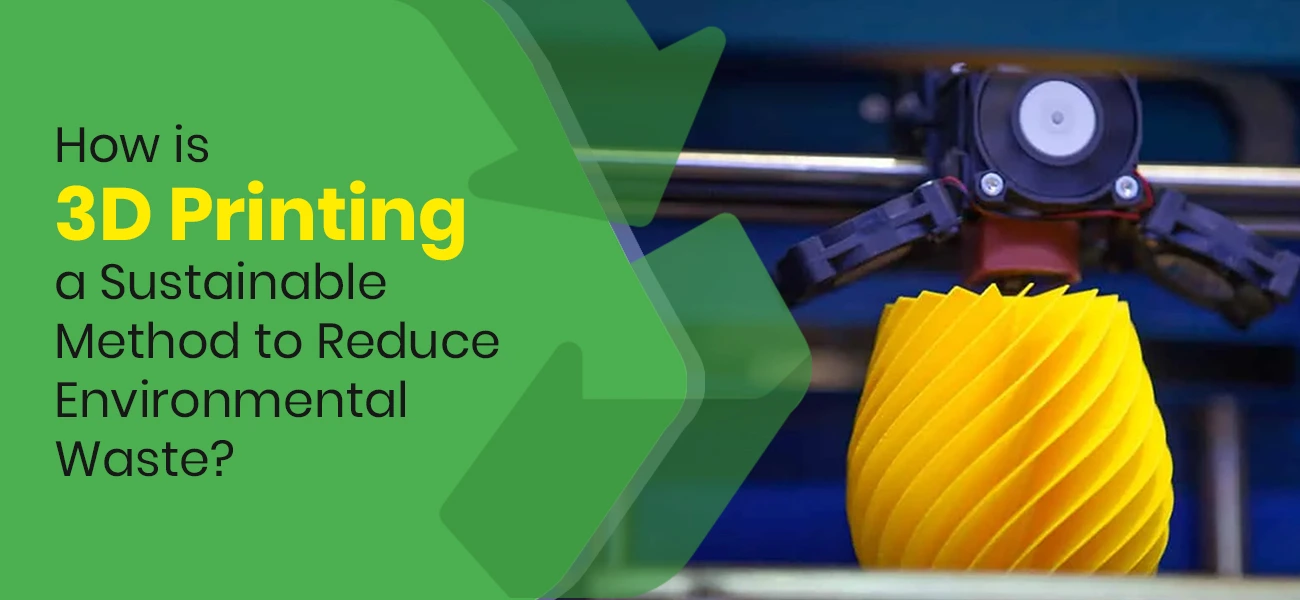How is 3D printing a sustainable method to reduce environmental waste?

Curious about the importance of 3D printing technology and the potential sustainability it holds over the current manufacturing process? Then stick with us until the end and get to know how viable additive manufacturing is, and how does 3D printing products reduce waste!
Ways to make manufacturing process more sustainable using 3D printing
Amidst all the discussion and speculation, it is safe to say that 3D printing methodologies do have significant environmental benefits over the traditional approach.
If you wonder how, by meeting the three major criteria of sustainability: the ability to reduce, reuse, and lastly, recycle.
In additive manufacturing, as the name suggests, the models or prototypes are created by adding materials and not subtracting, thus producing significantly fewer waste by-products. The possibilities do seem unlimited. Check them out below!
-
3D Printing drastically reduces material waste
The best part about this manufacturing technology is that the 3D printer utilizes the exact amount of resources and materials required to develop a model prototype - nothing more than that.
Be it metal or plastic, in the additive manufacturing process, the material is put exactly where it is required, rather than carving or scraping out parts or pouring molten metal in molds, thereby creating metal scraps as by-products.
This helps to prevent the trimming of any excess material, unlike traditional methods such as laser cutting or milling. Based upon a pre-developed CAD drawing, the printer leaves hollow spaces in the middle of the model wherever material is not required. The entire process reduces the carbon footprint to a great extent.
-
Less carbon-heavy transport
Mainly, the huge carbon emissions of traditional manufacturing are due to the supply chain system required to transport the goods from one place to another. This logistics and locomotion consume a lot of energy and emit considerable CO2 into the atmosphere.
On the other hand, the additive manufacturing process saves a lot of fuel. The 3D-printed models are designed and developed virtually and can be shared virtually with the clients through emails for further review or final production. Since little travel and transportation are involved, 3D printing is consequently sustainable.
-
Reduces the storage of huge stocks in the warehouse
With the usage of 3D printing technology, the manufacturer can print on-demand or in smaller batches per the order requirement instead of maintaining a full-fledged inventory stacked with overstock and spare parts. Thus, stock wastage and revenue risk can be significantly curtailed.
This is also deemed JIT (just-in-time) manufacturing where manufacturers print products only when the order is placed. The JIT approach to manufacturing products has massive potential in the eyewear industry, wherein using 3D printing, each frame could be custom-created on-demand.
This trend is evident in several global eyegear brands collaborating with Materialize, a Belgium-based 3D printing company, to produce 3D printed eye wearables collections.
-
3D printing uses eco-friendly raw materials
Another great aspect of the 3D printing method is its use of environmentally friendly and biodegradable raw materials. For example, ABS (acrylonitrile butadiene styrene), a thermoplastic polymer commonly used for additive manufacturing, lasts for a very long time and is biodegradable to some extent.
Mostly polymers like ABS, PEEK (poly ether ester ketone), etc., are used to develop parts of aircraft and vehicles. Another element, the PLA (polylactic acid) plastic, is much more eco-friendly and degrades very quickly.
Hence, most manufacturing companies that use 3D printing utilizes PLA for their printer.
-
New innovations without limits with 3D printing
Applications of 3D printing also give designers a way to design more efficiently and with greater innovation without being too hard on the environment. This not only boosts operational efficiency but also lessens the runtime of industrial appliances, which automatically helps reduce carbon emissions.
By additively manufacturing whatever components they need, manufacturers can positively impact on the planet.
-
AM (“Additive Manufacturing”) creates lightweight products
The materials mentioned above that are used are extremely lightweight and durable. Products created with these components tend to last longer than their traditional counterparts. This, in turn, creates lower demands, which implies lower supply and product development.
Thus, even indirectly, the method of 3D printing helps emit fewer greenhouse gases and reduce energy consumption.
-
Quick and easy repair of broken 3D printed parts
If a 3D-printed product is broken, there’s no need to entirely discard it because repairing broken parts and acquiring spare parts is too easy with 3D printing. With the help of simple superglue, you can repair a broken part and make it as good as new.
Apart from this, there are several other ways of fixing broken 3D-printed parts. A more professional way of doing it is the “sanding and filling” option, where the manufacturer sands the surface, making it even, with the help of electric modeling tools like “Dremel”, and then fills it with a 3D-printed filler.
Another alternative is to use a 3D pen that can effectively re-structure the broken part. With all these less expensive methods, one can repair and reuse old products instead of buying new ones.
This also proves the fact that 3D printing is indeed an environmentally sustainable manufacturing alternative.
-
3D printing utilizes recycled filaments and materials
This might sound unreal, but the 3D printing technology actually uses up recycled materials and filaments. This was evident in the 2020 Tokyo Olympics, where the podiums were made entirely by 3D printing using recycled filaments.
Usually, in traditional product manufacturing, prototypes and initial versions of products are made and then discarded if any design flaws are noticed. The process continues until the design is 100% flawless, resulting in several discarded, yet reusable elements. In additive manufacturing, all of these discarded elements can be recycled and reused.
Furthermore, post-consumer plastic waste can be used up in 3D printing, which is a viable solution for getting rid of plastic from the environment in a productive way.
“Filamentive PETg” is a perfect instance of recycled 3D printer filament created from consumer-recycled content, produced from discarded PETg plastic waste that otherwise goes to landfill. The raw material is first sourced from a conventional manufacturer; then, the plastic is sorted, cleaned, and shredded into a homogenous grey material.
Finally, a high-quality masterbatch - a solid plastic additive, is added to give the grey pellets a colored form, and a recycled, reusable product is extruded out of it.
Future of 3D printing in manufacturing industry to reduce emissions
The possibilities with 3D printing and additive manufacturing technology are endless. Companies are increasingly encouraged and incentivized to implement sustainable raw materials within their printing workflow. For example, used coffee grounds, cellulose, algae, etc.
Researchers and scientists also strive to create more eco-friendly raw materials, such as bio-degradable corn-based plastic with low carbon emissions, and contribute to eco-friendly waste disposal.
It is also a mentionable fact that although 3D printing relies heavily on plastic and polymer, that’s only true for desktop-grade printers. Industrial printers use many organic resources, ranging from wood, metal, ceramic, glass, and much more.
Also, extensive research is underway to produce 3D-printed human organs and parts using bio-ink made of human cells.
A California-based 3D printing construction firm, Mighty Buildings, recently formed a partnership with Fortera, a San-Jose-based materials technology company. The agenda behind this visionary partnership is Fortera’s breakthrough innovation in producing a type of cement that curbs CO2 emissions by more than 60% compared to conventional, old-school concrete-based cement.
This partnership will further allow a strategic liaison between the two organizations to address the US housing availability crisis and fight the eco-hazards, paving the way to carbon-neutral construction by 2028.
According to a projection by the U.S. Department of Energy, by 2050, 3D printing and additive manufacturing technology can save up to 90% of waste and raw materials, as well as reduce manufacturing energy consumption to half.
All these facets have a great potential for this technology and its future, as well as those new-age companies considering adapting to 3D printing!
Wrapping up!
As conclusion, it can safely be said that comparing both traditional process of product manufacturing and the advanced additive manufacturing through 3D printers, the latter has far less environmental adverse effects.
Considering the raw materials procurement, assembling, cleaning and refining, manufacturing, and finally the final usage - 3D printing definitely emerges as the winner in reducing carbon footprint.
In spite of having some flaws, this modern manufacturing process has the potential of making our manufacturing processes further sustainable in the future. There are several companies who are already leveraging this technology, and professional 3D artists strive their best to develop custom print-ready models with their on-demand 3d print design services.
You can get in touch with any 3D modeling firms offering high-end 3D modeling services and get yourself custom-designed print-ready models of your products.
With the 3D printing technology, let’s look at a greener, more sustainable future for the generations to come!
Get in touch!

